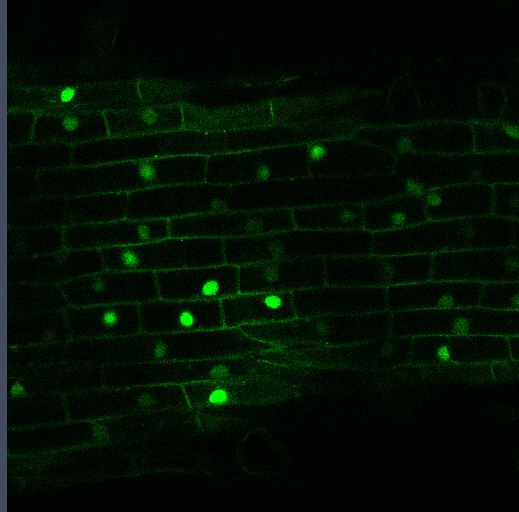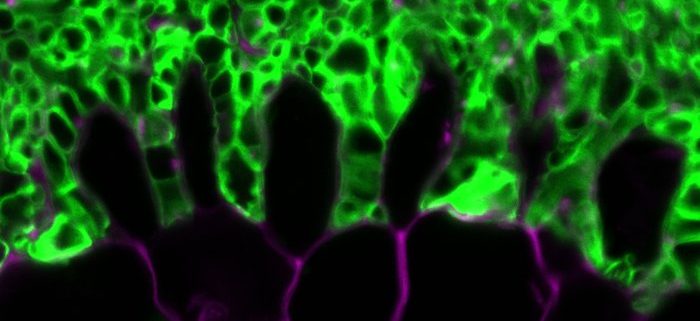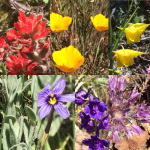The common symbiosis pathway: More common than we thought?
Cope et al. show how lipochitooligosaccharides produced by the mycorrhizal fungus Laccaria bicolor enhance colonization of Populus roots Plant Cell https://doi.org/10.1105/tpc.18.00676
By Kevin R. Cope, University of Wisconsin–Madison (currently at S. Dakota State Univ.) and Jean-Michel Ané, University of Wisconsin–Madison
Background: Most land plants form mutually beneficial associations with arbuscular mycorrhizal fungi. These fungi develop specialized nutrient exchange structures called arbuscules within the cells of plant roots. Woody plants, such as trees, can also associate with ectomycorrhizal fungi, which colonize the root surface and develop a network of hyphae known as the Hartig net (shown in the image above) between plant cells, but not within them. In these associations, the fungus (green) provides the plant (purple) with mineral nutrients that it imports from the soil. In return, the plant provides the fungus with fixed carbon derived from photosynthesis. Both types of mycorrhizal associations play essential roles in environmental and agricultural settings. Understanding the molecular mechanisms that regulate their association with plants can help improve crop productivity and agricultural sustainability.
Question: Athough our knowledge of how plants regulate ectomycorrhizal associations is limited, we know much more about arbuscular mycorrhizal associations. Do plants like poplar trees, which associate with both ectomycorrhizal and arbuscular mycorrhizal fungi, use similar signals and signaling pathways to associate with both types of symbionts?
 Findings: We discovered that Laccaria bicolor, an ectomycorrhizal fungus, produces diffusible signals known as lipochitooligosaccharides, which are similar to those produced by arbuscular mycorrhizal fungi and rhizobial bacteria. In legumes, these molecules are perceived by specific receptors and activate a common symbiosis pathway, which includes bursts of calcium (calcium spiking) within and around plant nuclei. We demonstrated that the diffusible signals produced by L. bicolor trigger calcium spiking by activating this signaling pathway in the roots of poplar trees. We also showed that, by decreasing the expression of genes from this pathway, we could affect not only calcium spiking but also the association between poplar and L. bicolor, thus demonstrating the relevance of these lipochitooligosaccharides and this signaling pathway in the establishment of ectomycorrhizal associations.
Findings: We discovered that Laccaria bicolor, an ectomycorrhizal fungus, produces diffusible signals known as lipochitooligosaccharides, which are similar to those produced by arbuscular mycorrhizal fungi and rhizobial bacteria. In legumes, these molecules are perceived by specific receptors and activate a common symbiosis pathway, which includes bursts of calcium (calcium spiking) within and around plant nuclei. We demonstrated that the diffusible signals produced by L. bicolor trigger calcium spiking by activating this signaling pathway in the roots of poplar trees. We also showed that, by decreasing the expression of genes from this pathway, we could affect not only calcium spiking but also the association between poplar and L. bicolor, thus demonstrating the relevance of these lipochitooligosaccharides and this signaling pathway in the establishment of ectomycorrhizal associations.
Next steps: Ectomycorrhizal fungi are diverse and colonize many woody plant species. Our goal is to determine which ectomycorrhizal fungi produce lipochitooligosaccharides and whether they use them to colonize their host plants, particularly hosts like pine that lack the components of the common symbiosis pathway and cannot associate with arbuscular mycorrhizal fungi.
Kevin R. Cope, Adeline Bascaules, Thomas B. Irving, Muthusubramanian Venkateshwaran, Junko Maeda, Kevin Garcia, Tomás Rush, Cathleen Ma, Jessy Labbé, Sara Jawdy, Edward Steigerwald, Jonathan Setzke, Emmeline Fung, Kimberly Schnell, Yunqian Wang, Nathaniel Schlief, Heike Bücking, Steven H. Strauss, Patricia Jargeat, Guillaume Bécard, Virginie Puech-Pagès, and Jean-Michel Ané (2019). The Ectomycorrhizal Fungus Laccaria bicolor Produces Lipochitooligosaccharides and Uses the Common Symbiosis Pathway to Colonize Populus Roots. Plant Cell. https://doi.org/10.1105/tpc.18.00676
Key words: Populus, mycorrhizae, calcium spiking, common symbiosis pathway




